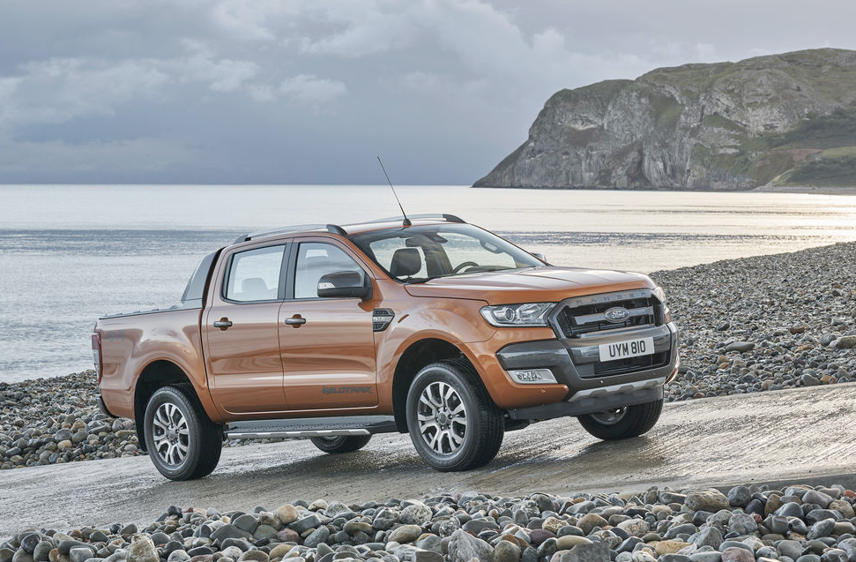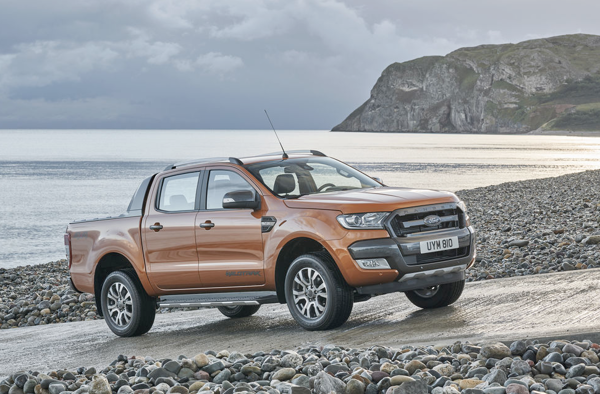Review
The UK is awash with new four-wheel drive contenders, as many major manufacturers are either launching fresh models or rebadging existing ones.
First, we had a new Mitsubishi L200, bringing with it improved levels of drivability and technology, closely followed by the Nissan NP300 Navara, which has been receiving plaudits all round.
We’ve now seen an upgraded Toyota Hilux, while Renault has announced its first-ever four-wheel drive truck, the Alaskan (a rebadged Navara), and Fiat will be rebadging the L200 as the Fullback. It is into this crowded arena that Ford is launching its new Ranger – and, with the power of the blue oval behind it, great things are expected.
The Ranger has had a spectacular rise in fortunes in the past few years. It is now Europe’s top-selling pick-up, with a market share rising from 10% in 2010 to 24% in 2015, on sales of 27,000 units. Meanwhile, in the UK the outgoing model was market leader in January and February, after sitting in third place behind the Mitsubishi L200 and Toyota Hilux in 2015, with sales of 8,033.
The new model, on sale now, features even more muscular looks, upgraded engines offering up to 17% better fuel efficiency and a range of technological improvements that would have been unimaginable even 10 years ago. Looking back at the agricultural offerings that were deemed cutting edge back then, it is clear this sector of the LCV market has come on more than any other in the past decade.
One immediate advantage that the Ranger has over, say, the Nissan NP300 Navara is that it is available in single-cab, king-cab and double-cab formats. The Navara doesn’t come with a single cab. While the ‘cooking’ versions represent a small portion of total sales – Ford’s is 1.5% at present – it is nevertheless a vital requirement for fleets that need rugged vehicles without extra seats and upgrades such as alloy wheels and leather seats.
The three models on offer have four spec levels: XT, XLT, Limited and Wildtrack. Basic versions have as standard steel wheels, silver grille, body-coloured bumpers, electronic stability control (ESC) with traction control and emergency brake assist, a digital radio, heated windscreen, electric mirrors and windows and front, side and knee airbags. XLT adds alloy wheels, foglights, side steps, air-conditioning, voice control for connected media, cruise control and a tyre pressure warning system.
Limited models add bigger alloy wheels, tinted windows, sports bars, heated leather seats and rear parking sensors while Wildtrack has even larger alloys, titanium-effect front grille, special seat trim and floor mats and a reversing camera. Prices go from £18,871 to £31,494 ex-VAT.
Under the bonnet there’s a choice of engines: a 2.2-litre four cylinder diesel and 3.2-litre five-cylinder. Both are Euro 5 compliant but Euro 6 engines in both sizes will be available from May and will have AdBlue tanks which will have to be filled every 5,000 miles. As yet, prices for Euro 6 models haven’t been revealed but it is likely that they will be higher.
The smaller engines pump out 160hp, while the large one offers a meaty 200hp. Meanwhile, CO2 emissions range from 171g/km to 234g/km. Fuel economy on the combined cycle ranges from 31.7mpg to 43.5mpg. Towing weights go from 1,800kg to 3,500kg, payloads range from 1,033kg to 1,269kg and towing weights go up to 3,500kg.
On the technology front, the new Ranger offers electric power-assisted steering for greater accuracy on the bends, a lane-keeping alarm system and a forward alert and collision mitigation system which will help avoid shunts by applying the brakes if the vehicle feels itself in an emergency situation. There’s also front and rear parking assist, adaptive cruise control and traffic sign recognition which will alert drivers when they are entering a speed restriction zone. Most of these systems are paid-for extras depending on the spec level chosen.
Normally on launches such as this, the manufacturers offer journalists only the top spec models dripping with paid-for extras but, on this occasion, Ford had just one single-cab bottom spec version available to test – so while others headed for the more expensive models, Commercial Fleet was able to test the model many readers will be most interested in.
It proved a real eye-opener as, while we were not exactly expecting a great deal of comfort and general driver goodies, that’s exactly what we got.
At £18,870, excluding VAT, this ‘farmer’s truck’ features wide, comfortable seats with plenty of side support, two 12-volt take-off points on the dash, electric windows, a USB port and a sunglasses holder in the roof. There are also proper carpets on the floor in place of the usual rubber mats and even cloth inserts in the side panels.
The cargo area measures a useful 2,317mm in length and there was a hose-clean plastic load-liner (which turned out to be a £250 option) and plenty of lashing-down points. The powerplant – 2.2-litres, 160hp – fires up quietly and even at motorway speeds there was very little noise in the cab.
The rather long throw gear lever provides nice neat changes and, apart from the skittishness we normally find in these sorts of trucks which don’t have any cargo in them (we could have done with a large lump of concrete in the back to hold the rear end down a bit), the Ranger handles corners with ease.
Our next test vehicle was the top-of-the-range 3.2-litre Wildtrack and this more upmarket model seemed like unashamed luxury compared to the single-cabber. Leather seats, alloy wheels, just about every extra feature imaginable and a stonking five-cylinder 200hp powerplant to boot. It might be aimed more at owner-drivers, but it’s certainly a powerful business tool too, which will give any company that uses it a very upmarket image.
Part of our test drive took part on an excellent off-road course in Buckinghamshire – and here the Ranger showed its prowess in the mud. We tried the 2.2-litre double-cab mated to an auto gearbox and, with both hill descent control and hill hold control as standard, we simply took both feet off the controls during the scary bits and let the truck do the work itself, almost as if by magic.
On a particularly deep stretch of stream we were told by our instructor that the Ranger has a best-in-class wading depth of 800mm – that’s 300mm more than the Land Rover Defender.
Off-road experts may grumble that all this technology takes the fun out of off-road driving, but if the vehicle is being used for business then, as far as we are concerned, the more safety technology on board the better.
Verdict
While all the new four-wheel drive models we’ve tested recently are capable and superb to drive, we feel that Ford’s might in the fleet industry and enviable dealer network may just help swing buyers in the Ranger’s direction.
Specs
| Manufacturer | Ford |
| Model | Ranger Light Commercial |
| Specification | Ford Ranger Diesel Pick Up Double Cab Raptor 2.0 EcoBlue 210 Auto |
| Model Year | 2025.00 |
| Annual VED (Road tax) | £1035 |
| BIK List Price | £48,741 |
| CO2 | 278g/km |
| Insurance Group | N/A |
| CC | 1,996 |
| Fuel Type | |
| Vehicle Type | Pick-up |
| Luggage capacity (Seats up) | N/A |
Running Costs
| P11D | £48,741 |
| Cost per mile | 70.09ppm |
| Residual value | £23,100 |
| Insurance group | N/A |
| Fuel Type | |
| Cost per mile | 70.09ppm |
| Fuel | 22.50ppm |
| Depreciation | 42.83ppm |
| Service maintenance and repair | 4.76ppm |
Rivals
Info at a glance
-
P11D Price
£48,741
-
MPG
26.6 -
CO2 Emissions
278g/km -
Payload
N/A -
Load Volume
N/A -
Load Width
N/A -
Load Length
5,370mm





 Diesel
Diesel












